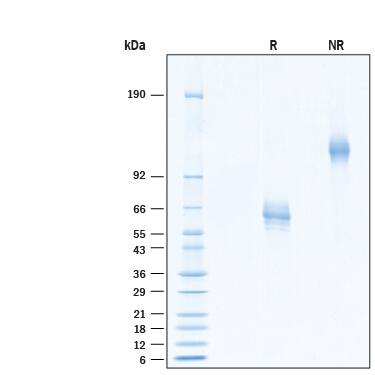Recombinant Human R-Spondin 3 Fc Chimera Protein, CF
R&D Systems, part of Bio-Techne | Catalog # 11506-RS

Key Product Details
Product Specifications
Source
Chinese Hamster Ovary cell line, CHO-derived human R-Spondin 3 protein
| Human RSPO3 (Met33-Gly209) Accession # Q9BXY4.1 |
IEGRMD | Human IgG1 (Pro100-Lys330) |
| N-terminus | C-terminus |
Purity
>95%, by SDS-PAGE visualized with Silver Staining and quantitative densitometry by Coomassie® Blue Staining.
Endotoxin Level
<0.10 EU per 1 μg of the protein by the LAL method.
N-terminal Sequence Analysis
Met33
Predicted Molecular Mass
46 kDa
SDS-PAGE
53-69 kDa, under reducing conditions.
Activity
Measured
by its ability to activate TCF reporter activity in HEK293 human embryonic
kidney cells in the presence of Recombinant Human Wnt-3a
(Catalog #
5036-WN).
The ED50 for this effect is 0.500-10.0 ng/mL.
Scientific Data Images for Recombinant Human R-Spondin 3 Fc Chimera Protein, CF
Recombinant Human R‑Spondin 3 Fc Chimera Protein Bioactivity.
Recombinant Human R-Spondin 3 Fc Chimera Protein (Catalog # 11506-RS) activates TCF reporter activity in HEK293 human embryonic kidney cells in the presence of Recombinant Human Wnt-3a (5036-WN). The ED50 for this effect is 0.500-10.0 ng/mL.Recombinant Human R‑Spondin 3 Fc Chimera Protein SDS-PAGE.
2 μg/lane of Recombinant Human R‑Spondin 3 Fc Chimera Protein (Catalog # 11506-RS) was resolved with SDS-PAGE under reducing (R) and non-reducing (NR) conditions and visualized by Coomassie® Blue staining, showing bands at 53-69 kDa and 110-140 kDa, respectively.Formulation, Preparation and Storage
11506-RS
| Formulation | Lyophilized from a 0.2 μm filtered solution in PBS with Trehalose. |
| Reconstitution | Reconstitute the 20 μg size at 200 μg/mL in PBS. Reconstitute all other sizes at 500 μg/mL in PBS. |
| Shipping | The product is shipped at ambient temperature. Upon receipt, store it immediately at the temperature recommended below. |
| Stability & Storage | Use a manual defrost freezer and avoid repeated freeze-thaw cycles.
|
Background: R-Spondin 3
References
- Chen, J-Z. et al. (2002) Mol. Biol. Rep. 29:287.
- Kim, K.-A. et al. (2008) Mol. Biol. Cell 19:2588.
- Hendrickx, M. and L. Leyns (2008) Develop. Growth Differ. 50:229.
- Nam, J.-S. et al. (2007) Gene Expr. Patterns 7:306.
- Entrez Accession # EAW48114 and EAW48116.
- Kazanskaya, O. et al. (2008) Development 135:3655.
- Aoki, M. et al. (2007) Dev. Biol. 301:218.
- Binnerts, M.E. et al. (2007) Proc. Natl. Acad. Sci. USA 104:14700.
- Nam, J.-S. et al. (2006) J. Biol. Chem. 281:13247.
- Wei, Q. et al. (2007) J. Biol. Chem. 282:15903.
- Theodorou, V. et al. (2007) Nat. Genet. 6:759.
Long Name
Roof Plate-specific Spondin 3
Alternate Names
Cristin 1, PWTSR, RSPO3, RSpondin 3, THSD2
Gene Symbol
RSPO3
UniProt
Additional R-Spondin 3 Products
Product Documents for Recombinant Human R-Spondin 3 Fc Chimera Protein, CF
Product Specific Notices for Recombinant Human R-Spondin 3 Fc Chimera Protein, CF
For research use only
